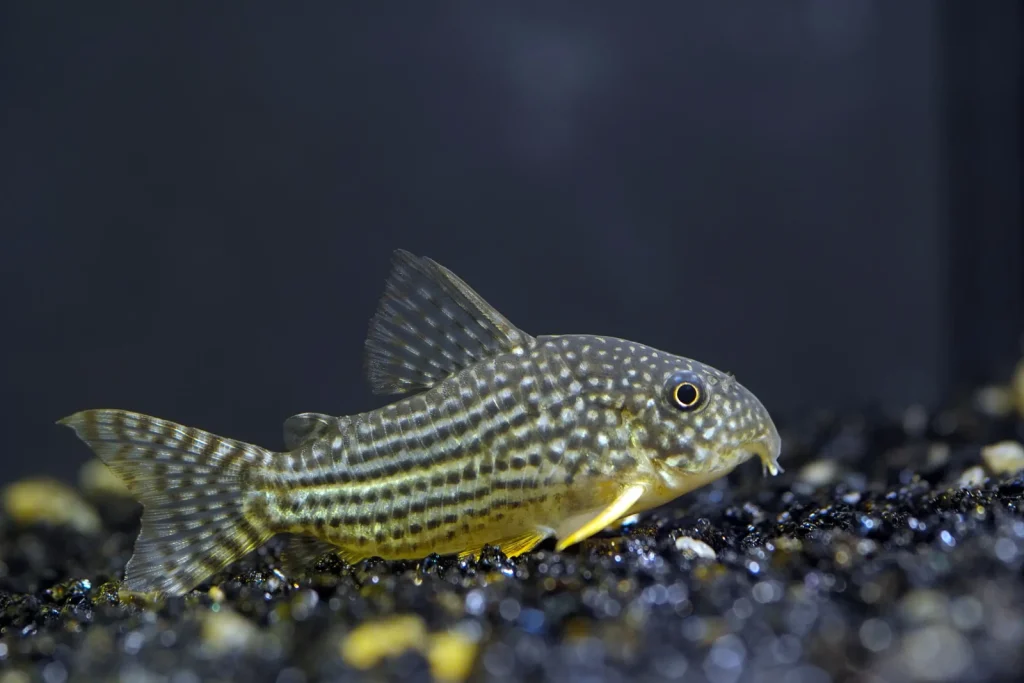Introduction
The Corydoras Catfish (Corydoras spp.) is a popular bottom-dwelling fish known for its peaceful nature, active personality, and ability to keep the aquarium clean. These fish are excellent for community tanks and come in a variety of species, each with unique patterns and colors. This guide covers everything you need to know about Corydoras Catfish care, including the ideal Corydoras Catfish tank setup, diet, breeding, and water parameters.

Quick Facts
Common Name: Corydoras Catfish
Scientific Name: Corydoras spp.
Family: Callichthyidae
Lifespan: 5-10 years
Size: 1-4 inches (2.5-10 cm) depending on species
Tank Size: Minimum 20 gallons
Temperament: Peaceful, social
Diet: Omnivore
Water Parameters: pH 6.0-7.5, Temp 72-78°F
Natural Habitat & Corydoras Catfish Behavior
The Corydoras Catfish originates from freshwater rivers and streams in South America. They thrive in soft, sandy substrates where they forage for food along the riverbed.
In aquariums, Corydoras are highly active, social fish that prefer to be kept in groups of at least 6 to feel secure. They are bottom feeders and spend most of their time scavenging for leftover food while displaying playful behavior.
Corydoras Catfish Tank Setup & Requirements
Tank Size & Setup
- Minimum Tank Size: 20 gallons (larger for bigger species)
- Best Setup: A soft, sandy substrate with plenty of hiding spots (driftwood, caves, plants)
- Substrate: Fine sand is recommended to protect their sensitive barbels
Corydoras Catfish Water Parameters
- Temperature: 72-78°F (22-26°C)
- pH Level: 6.0-7.5
- Water Hardness: 2-12 dGH
- Filtration: Moderate filtration with good oxygenation
- Lighting: Low to moderate lighting
Corydoras Catfish Tank Mates & Compatibility
Corydoras Catfish are peaceful and make great additions to community aquariums. Ideal Corydoras Catfish tank mates include:
- Compatible Tank Mates: Tetras, Rasboras, Guppies, Dwarf Cichlids, Small Gouramis, Shrimp
- Avoid: Large aggressive fish (Oscars, Jack Dempseys, Large Cichlids)
Corydoras Catfish Diet & Feeding
What They Eat in the Wild
The Corydoras Catfish diet consists of small invertebrates, insect larvae, and plant matter found in their natural habitat.
Best Foods in Captivity
- Staple Diet: Sinking pellets and wafers designed for bottom feeders
- Treats: Live or frozen foods (bloodworms, daphnia, brine shrimp)
- Feeding Frequency: 1-2 times per day, ensuring food reaches the bottom of the tank
Corydoras Catfish Breeding
Breeding Tank Setup
- Tank Size: 10-15 gallons (for breeding pairs)
- Water Conditions: Cooler water temperatures and frequent water changes to trigger spawning
- Temperature: 72-75°F (22-24°C)
- Decor: Fine sand substrate, smooth rocks, and broad-leaved plants
Breeding Process
- Spawning Behavior – Males chase the female until she selects a suitable spawning site.
- Egg-Laying & Fertilization – Females lay adhesive eggs on glass, leaves, or decorations.
- Egg & Fry Care – Remove adults after spawning to prevent them from eating the eggs.
Fry Care
- First Foods: Infusoria or powdered fry food
- Growth Stages: Introduce baby brine shrimp as they grow
- Tank Conditions: Stable water conditions are crucial for fry survival
Common Health Issues & Prevention
Common Diseases
| Disease | Symptoms | Treatment |
|---|---|---|
| Ich (White Spot Disease) | White cysts on body and fins | Increase temperature, use anti-parasitic meds |
| Fin Rot | Frayed, discolored fins | Improve water quality, use antibacterial meds |
| Fungal Infections | Cotton-like growths on body | Anti-fungal medication, water changes |
Prevention Tips
- Maintain Clean Water: Perform regular water changes (25% weekly)
- Quarantine New Fish: Prevent disease spread
- Avoid Overfeeding: Reduces waste buildup and improves water quality
FAQs
Q: How many Corydoras should be kept together?
A: At least 6 to promote natural social behaviors and reduce stress.
Q: Can Corydoras live in a community tank?
A: Yes, they thrive in peaceful community tanks with similarly sized fish.
Q: Do Corydoras need an air pump?
A: No, but good filtration and oxygenation are beneficial for their well-being.
Conclusion
The Corydoras Catfish is an active, social, and low-maintenance fish that makes an excellent addition to community aquariums. By providing the right Corydoras Catfish tank setup, diet, and water parameters, you can enjoy their lively and peaceful nature for many years.
